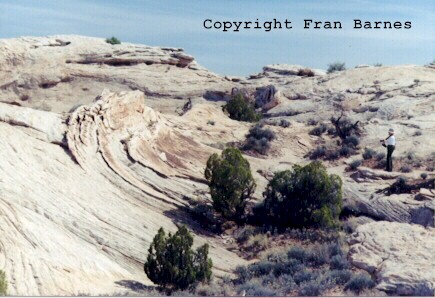
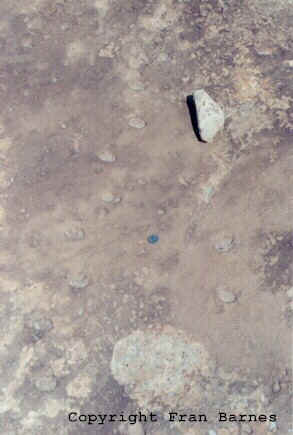
Navajo Fossil Specimens in the Moab Area
A Paleontology Challenge and Call for Research
To: All geologists, paleontologists and paleobotonists who think the vast, mid-Jurassic dune-sand desert represented by the Navajo, Nugget and Aztec sandstone formations was too hot, arid and/or mineralized to support significant life.
From: A group of amateur earth scientists
-----------------------------------------------------------------------------------------------------------------------
We contend that at least part of the paleo-environment of this immense region the dominated the western coastlands of Pangea during the mid-Jurassic was inhabited throughout its existence by a wide range of reptiles, early mammals, dinosaurs, perhaps pterosaurs and other life forms. To quote Martin Lockley:
"The Navajo formation is full of fossil tracks representing diverse animal communities. Although tracks are known from almost every Mesozoic formation in Utah, the Navajo formation currently reveals the most varied assemblage of footprints. The curious paradox indicates that the desert environment, traditionally regarded as hostile to life, [somehow] supported one of the most diverse ancient animal communities ever documented on the basis of the fossil footprint record."
In addition to footprints, the Navajo formation has produce other intriguing fossil evidence. This evidence includes many long-standing mini-forests associated with mineralized playa dry lakes, the burrows of mammal-like reptiles and other trace fossils that suggest aggregate forms of life. It is quite obvious that life thrived and was uniquely adapted to this harsh environment.
The details of this paleo-ecosystem are rather intriguing. Perhaps the food chain was not based on the usual vegetation/herbivore/carnivore energy pyramid ? Perhaps this nutrient cycle evolved around the fluctuating nature of the dry lake beds? Occasional torrential rains could have produced life giving water for these normally dry desert playas. This, in turn would have revived a myriad of dormant life forms that had evolved adaptive life cycles species such as mollusks, crustaceans, amphibians, reptiles, insects, worms and countless forms of micro-life. It is possible, then, that this sudden bloom of life could have attracted and supported a roaming population of carnivores without the need for a large population of herbivores.
These and many other intriguing questions have not yet been rigorously investigated by paleontologists. It would be thrilling to identify the type of trees that existed in this pale0-environment. Was it the extinct Cheirolepidiaceae that was adapted for drought or some other type of conifer that still surives in the modern world? How were the seeds of these trees dispersed? How long did playa lakes last and how many different life forms did they support? What ended the deposition of Navajo Sandstone?
Fran Barnes of Moab, Utah who has over 30 years of field experience and has authored numerous natural history books has personally catalogued a rich collection of fossil sites in the Navajo Sandstone formation. He is willing to assist serious scientific inquiry and study of these sites. He can be contacted at (435) 259-6700.
News Update! A new trackway site was discovered April 2000.


This site is the newest and strangest discovery of small animal tracks within Navajo Sandstone. From its appearance the new discovery was promptly dubbed "The Breaking Wave Track Site. The lower part of the "breaking wave" slope that is stained with light brown desert varnish has numerous small animal tracks with several multi-step trackways ascending its slope. The unusual configuration of the aeolian strata as the site is what first attracted the attention of the discovery party and poses a serious puzzle for sedimentologists, as do similar sites nearby.
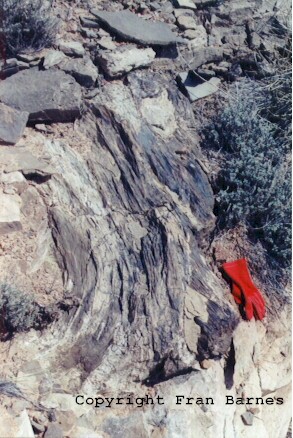
This large fragment of a lithified log is eroding from sediments associated with relatively thin playa limestone in mid-Navajo Sandstone. Since the log extends underground, it is probably much larger. More of it is showing through the decomposing rock a few feet away, and there are other sizable petrified logs or roots exposed nearby in the same stratigraphic position. The log and several others found elsewhere, seems to have different grain structures than most of the lithified logs found in the Navajo Sandstone in this vicinity possibly indicating that more than one species of tree was able to thrive is such a hot, saline environment.
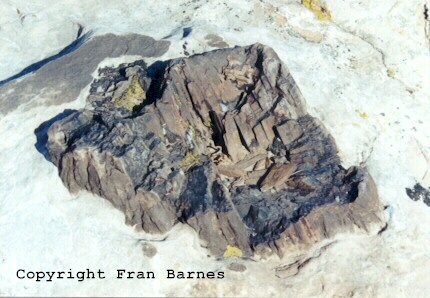
This photograph shows a typical petrified log or root eroding from the
white aeolian sandstone far beneath a layer of desert-playa limestone at a different site.
There are others like this in the vicinity, in addition to numerous loose pieces of
the same material already eroded out of their sandstone matrix.
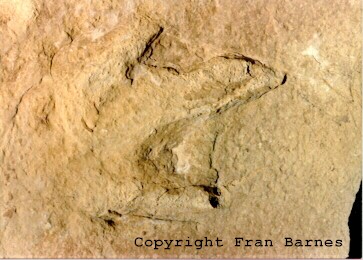
Predator dinosaur tracks have been found throughout the entire time span of the Navajo Sandstone formation from top to bottom but no large herbivore tracks have been discovered yet in the Moab area. This would tend to indicate that the Navajo paleo-environment was able to support such large carnivores in some unusual manner perhaps by predation upon the small animals that made numerous burrows. The entire question of the food-pyramid in the Navajo paleo-environment should be investigated, because there is now plentiful field evidence indicating the conventional view of a very hot arid equatorial desert totally devoid of life needs re-examination.
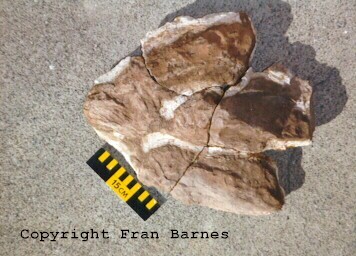
At petrified wood site #6 (associated with a typical short-lived playa limestone deposit) there are a number of theropod dinosaur tracks of various sizes. Mineral developers bulldozed a road through the perimeter of the site and inadvertently broke apart several unusual foot track impressions that had been exposed by erosion. The impressions had apparently formed when the dinosaurs stepped in multi-layered sediments which subsequently lithified to varying degrees, allowing the compressed tracks eventually to erode from their matrix. This picture shows the bottom of one such track after its scattered pieces were fitted together and re-joined with an epoxy adhesive. It is now in the museum of the University of Utah.
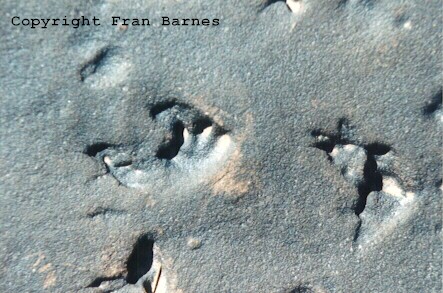
Possible tracks from an early-pterosaur. Note 4th digit which extends out at an
angle.
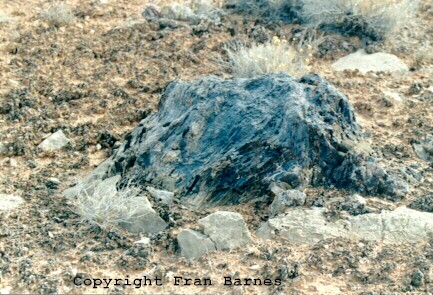
This large stump protrudes upward through the limestone layer of a desert playa, bulging it upward around the stump's perimeter. There is a similar stump nearby in this extensive exposure of petrified wood near the top of the Navajo Sandstone deposit. For scale, the exposed part of the stump is about two feet in diameter at it's base. Parts of the the lithified tree are scattered down a nearby slope.
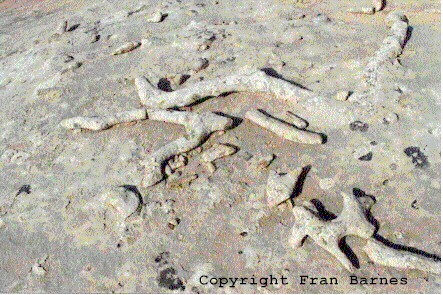
This is a typical exposure of the numerous small animal burrow-casts found in Navajo Sandstone. The burrow-casts at the various sites range in diameter from two to six inches, and are consistent with the very few fossils of small animals so far discovered in Navajo Sandstone. This desert-aeolian deposit generally offered very poor fossil-preserving opportunities, except in its numerous limestone playas and their perimeters but few studies of these have been made to date. Burrow-casts similar to those shown in this picture exist throughout the deposit, not only in the vicinity of playas but also in interdune areas and what appears to be dunes that were transiently wetted by passing storms. The numerous remains of burrows and burrow-casts in this deposit deserve comprehensive study.

In relatively rare locations within Navajo Sandstone, animal burrows were preserved intact, instead of the more typical solid burrow cast. Those in this photograph are about 5 inches in diameter and appeared to have been dug in the wetted deposits around the perimeter of a desert playa. This site, in mid-Navajo stratigraphy, is extensive with dozens of open burrows exposed by weathering.
To learn more about the Navajo
Sandstone fossil record follow the links below:
Introduction
Vertebrate Skeletal Fossils Invertebrate Skeletal Fossils
Vertebrate Trace Fossils Invertebrate Trace Fossils
Petrified Wood and Flora Casts Fresh Water Deposits